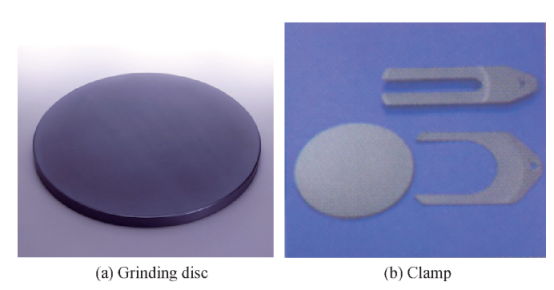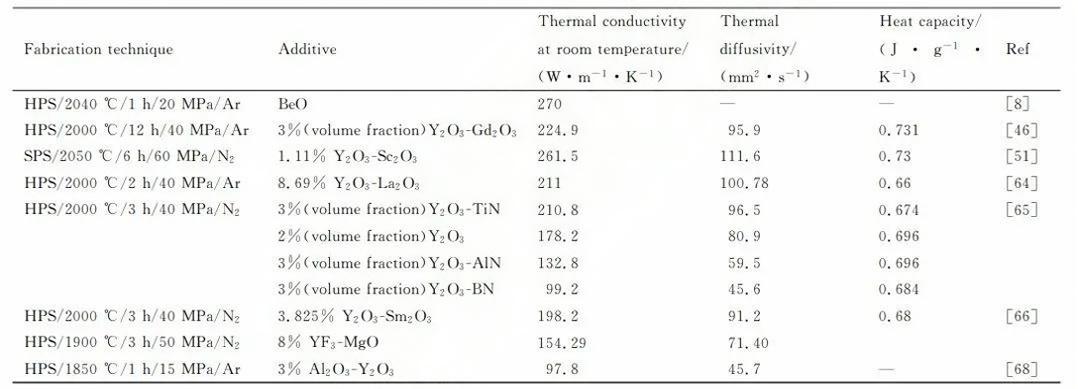Currently, silicon carbide (SiC) is a thermally conductive ceramic material that is actively studied at home and abroad. The theoretical thermal conductivity of SiC is very high, and some crystal forms can reach 270W/mK, which is already a leader among non-conductive materials. For example, the application of SiC thermal conductivity can be seen in the substrate materials of semiconductor devices, high thermal conductivity ceramic materials, heaters and heating plates for semiconductor processing, capsule materials for nuclear fuel, and gas sealing rings for compressor pumps.
Application of silicon carbide in the semiconductor field
Grinding discs and fixtures are important process equipment for silicon wafer production in the semiconductor industry. If the grinding disc is made of cast iron or carbon steel, its service life is short and its thermal expansion coefficient is large. During the processing of silicon wafers, especially during high-speed grinding or polishing, due to the wear and thermal deformation of the grinding disc, the flatness and parallelism of the silicon wafer are difficult to guarantee. The grinding disc made of silicon carbide ceramics has low wear due to its high hardness, and its thermal expansion coefficient is basically the same as that of silicon wafers, so it can be ground and polished at high speed.
In addition, when silicon wafers are produced, they need to undergo high-temperature heat treatment and are often transported using silicon carbide fixtures. They are heat-resistant and non-destructive. Diamond-like carbon (DLC) and other coatings can be applied on the surface to enhance performance, alleviate wafer damage, and prevent contamination from spreading.
Furthermore, as a representative of the third-generation wide-bandgap semiconductor materials, silicon carbide single crystal materials have properties such as large bandgap width (about 3 times that of Si), high thermal conductivity (about 3.3 times that of Si or 10 times that of GaAs), high electron saturation migration rate (about 2.5 times that of Si) and high breakdown electric field (about 10 times that of Si or 5 times that of GaAs). SiC devices make up for the defects of traditional semiconductor material devices in practical applications and are gradually becoming the mainstream of power semiconductors.
The demand for high thermal conductivity silicon carbide ceramics has increased dramatically
With the continuous development of science and technology, the demand for the application of silicon carbide ceramics in the semiconductor field has increased dramatically, and high thermal conductivity is a key indicator for its application in semiconductor manufacturing equipment components. Therefore, it is crucial to strengthen the research on high thermal conductivity silicon carbide ceramics. Reducing the lattice oxygen content, improving the density, and reasonably regulating the distribution of the second phase in the lattice are the main methods to improve the thermal conductivity of silicon carbide ceramics.
At present, there are few studies on high thermal conductivity silicon carbide ceramics in my country, and there is still a large gap compared with the world level. Future research directions include:
●Strengthen the preparation process research of silicon carbide ceramic powder. The preparation of high-purity, low-oxygen silicon carbide powder is the basis for the preparation of high thermal conductivity silicon carbide ceramics;
● Strengthen the selection of sintering aids and related theoretical research;
●Strengthen the research and development of high-end sintering equipment. By regulating the sintering process to obtain a reasonable microstructure, it is a necessary condition to obtain high thermal conductivity silicon carbide ceramics.
Measures to improve the thermal conductivity of silicon carbide ceramics
The key to improving the thermal conductivity of SiC ceramics is to reduce the phonon scattering frequency and increase the phonon mean free path. The thermal conductivity of SiC will be effectively improved by reducing the porosity and grain boundary density of SiC ceramics, improving the purity of SiC grain boundaries, reducing SiC lattice impurities or lattice defects, and increasing the heat flow transmission carrier in SiC. At present, optimizing the type and content of sintering aids and high-temperature heat treatment are the main measures to improve the thermal conductivity of SiC ceramics.
① Optimizing the type and content of sintering aids
Various sintering aids are often added when preparing high thermal conductivity SiC ceramics. Among them, the type and content of sintering aids have a great influence on the thermal conductivity of SiC ceramics. For example, Al or O elements in the Al2O3 system sintering aids are easily dissolved into the SiC lattice, resulting in vacancies and defects, which leads to an increase in the phonon scattering frequency. In addition, if the content of sintering aids is low, the material is difficult to sinter and densify, while a high content of sintering aids will lead to an increase in impurities and defects. Excessive liquid phase sintering aids may also inhibit the growth of SiC grains and reduce the mean free path of phonons. Therefore, in order to prepare high thermal conductivity SiC ceramics, it is necessary to reduce the content of sintering aids as much as possible while meeting the requirements of sintering density, and try to choose sintering aids that are difficult to dissolve in the SiC lattice.
*Thermal properties of SiC ceramics when different sintering aids are added
Currently, hot-pressed SiC ceramics sintered with BeO as a sintering aid have the maximum room-temperature thermal conductivity (270W·m-1·K-1). However, BeO is a highly toxic material and carcinogenic, and is not suitable for widespread application in laboratories or industrial fields. The lowest eutectic point of the Y2O3-Al2O3 system is 1760℃, which is a common liquid-phase sintering aid for SiC ceramics. However, since Al3+ is easily dissolved into the SiC lattice, when this system is used as a sintering aid, the room-temperature thermal conductivity of SiC ceramics is less than 200W·m-1·K-1.
Rare earth elements such as Y, Sm, Sc, Gd and La are not easily soluble in SiC lattice and have high oxygen affinity, which can effectively reduce the oxygen content of SiC lattice. Therefore, Y2O3-RE2O3 (RE=Sm, Sc, Gd, La) system is a common sintering aid for preparing high thermal conductivity (>200W·m-1·K-1) SiC ceramics. Taking the Y2O3-Sc2O3 system sintering aid as an example, the ion deviation value of Y3+ and Si4+ is large, and the two do not undergo solid solution. The solubility of Sc in pure SiC at 1800~2600℃ is small, about (2~3)×1017atoms·cm-3.
② High temperature heat treatment
High temperature heat treatment of SiC ceramics is conducive to eliminating lattice defects, dislocations and residual stresses, promoting the structural transformation of some amorphous materials to crystals, and weakening the phonon scattering effect. In addition, high-temperature heat treatment can effectively promote the growth of SiC grains, and ultimately improve the thermal properties of the material. For example, after high-temperature heat treatment at 1950°C, the thermal diffusion coefficient of SiC ceramics increased from 83.03mm2·s-1 to 89.50mm2·s-1, and the room-temperature thermal conductivity increased from 180.94W·m-1·K-1 to 192.17W·m-1·K-1. High-temperature heat treatment effectively improves the deoxidation ability of the sintering aid on the SiC surface and lattice, and makes the connection between SiC grains tighter. After high-temperature heat treatment, the room-temperature thermal conductivity of SiC ceramics has been significantly improved.
Post time: Oct-24-2024


